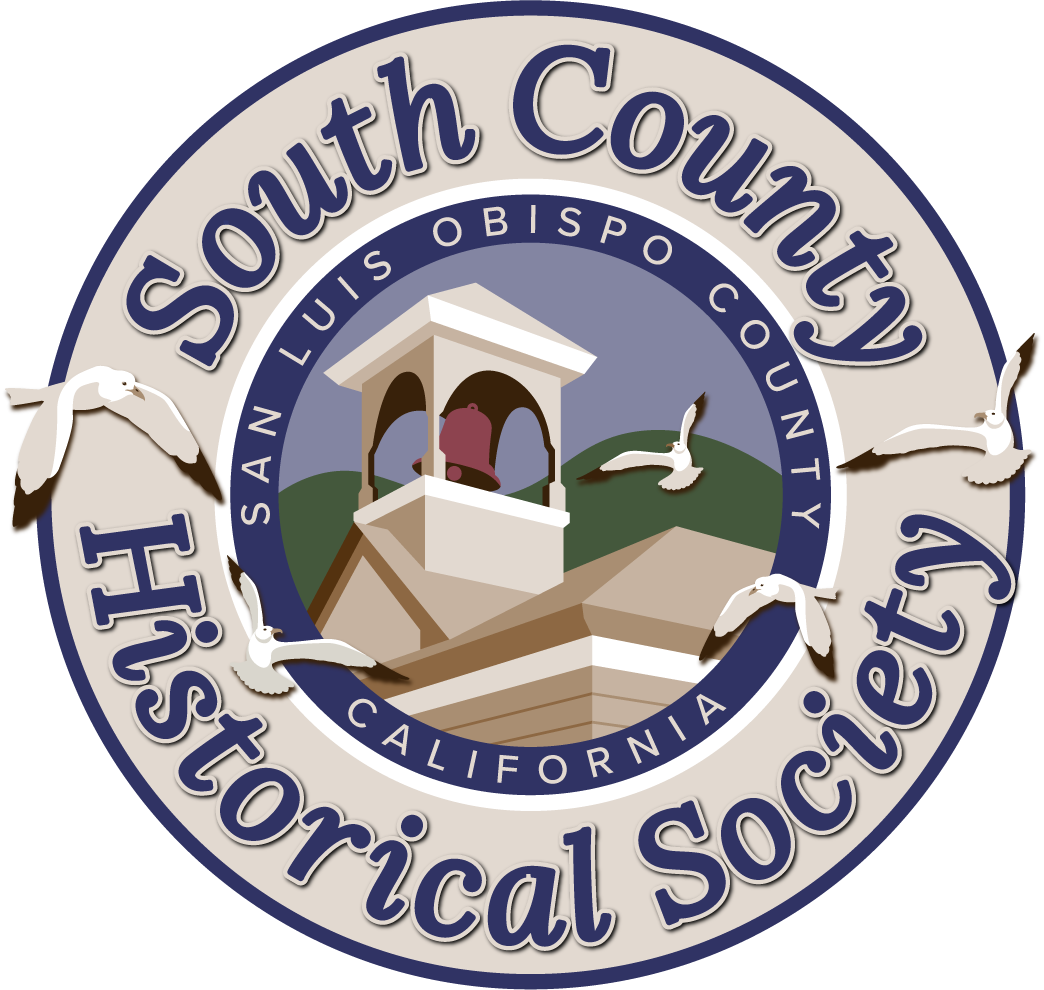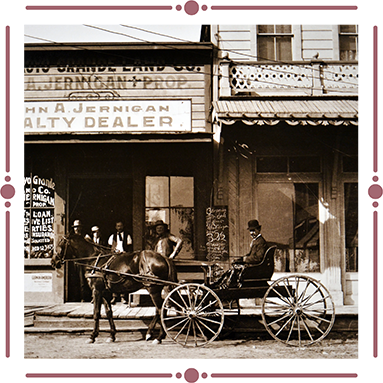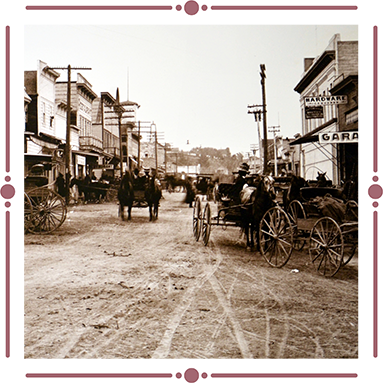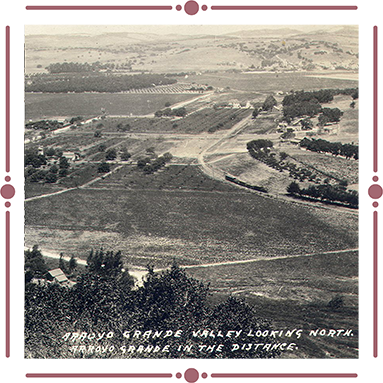



Huasna

The Huasna Valley is known for its prime farmland, supporting both fruit orchards and crops of vegetables, berries, flowers and herbs. Huasna is located 20 minutes from the town of Arroyo Grande on the California Central Coast. Vegetables grown in the Huasna area can be found every week at the local farmers' markets, held throughout the 5 Cities area.
The Huasna
By Jane Line
Over the last few months, I have written on a few of the eight communities who chartered themselves as the South County Historical Society in 1976. Our Society is pledged to preserve and disseminate the history of each of these original communities. A fascinating example of how intricately this local history still influences us and our membership today is what I write on in this newsletter.
Did you realize that Isaac Sparks’ Mexican Land Grand of 1843 in the Huasna tells the history in some part of three of our current members? Mr. Sparks divided his Huasna Rancho between two of his daughters, Flora and Rosa. Flora was Norma Harloe’s paternal grandmother and Rosa was Charles Porter’s paternal great-grandmother. The Porter Ranch story is as old as California rancho history can be during Mexico’s governance.
Additionally, around 1914, two descendants of pioneer families from Tennessee, Hamilton and Myrna Parks, bought the ranch sight unseen. Mr. Parks hired Mr. and Mrs. Hurman Ruedi to operate the ranch. This newly immigrated German couple were the mother and father of our own, Clara Ruedi Madsen. Clara was born on the ranch in 1916, spending the first nine years of her life being influenced by the rhythms of life in the Huasna, living in what was already an old Californio adobe. I have included an excerpt from Clara’s writings on her time in the Huasna further down in the this article.
First, however, the story begins with Norma Harloe’s family and their time in the Huasna.
The Huasna Rancho
Don’t you love the serendipitous nature of things that happen to us in the course of ‘following our bliss?’ Years ago, reading about the Harloe Adobe in According to Madge, I became fascinated with the idea that it just might be the oldest adobe in the county - especially the oldest that still stands. In time, I met Norma Harloe and learned more about the adobe and her family history from her. Charles Porter, a cousin of Norma’s, had more stories.
Norma told me that she had never been to the adobe that she could recall but that her older brother Leo had written his master’s thesis at USC on their great grandfather, Isaac J. Sparks, who obtained his Huasna Mexican land grant from the Governor of California in 1843. It appears the Huasna Adobe was designated as an historical landmark and in 1949 a bronze plaque was placed inside the house commemorating the event.
In part, the inscription reads:
CASA DEL RANCHO HUASNA
Living Room built about 1831
Addition built by Captain Marcus Harloe about 1869
Rancho granted to Isaac J. Sparks
Pioneer American Sea Otter Hunter
Trapper and Merchant of Santa Barbara County
December 8, 1843
By Governo Manuel Micheltorena
The Governor had granted his Yankee friend five leagues, including all of the Huasna Creek Valley, a major portion of the Huasna River Valley, part of the Alamo Creek Valley, and ranges of hills between them all, the richest soils in the area. When finally surveyed and patented in 1872-73, it totaled 22,152.99 acres.
Like all grantees of the day, Mr. Sparks was to abide by the requirements of the day for such a privilege, to wit: to become naturalized as a Mexican citizen, join the Catholic church, and marry a Mexican senorita. He married Maria de las Remedios Josefa Eayrs.
The Sparks never actually lived at Rancho Huasna, preferring instead to be closer to his business holdings in Santa Barbara. However, the ranch was stocked with cattle and sheep and its operation was entrusted to Englishman John Price who later acquired the Pismo Mexican grant from Sparks. The story goes that Mr. Sparks had previously won that land grant in an historic poker game with stakes that included the Huasna and Pismo ranchos, the Santa Barbara Channel Islands, and other vast holdings. Imagine!
Meanwhile, on a hill on the Rancho Huasna, the thick-walled adobe hacienda still stands, its construction attributed to either Sparks’ cattle partner, George Stone, or to an earlier trapper named Mason in 1831. At this time, the adobe probably consisted of one or two rooms with a fireplace and a gently gabled sod roof.
Shortly before his death in 1867, Isaac Sparks divided the ranch among two of his three daughters. Flora, Norma’s paternal grandmother, acquired the portion upon which the adobe stood. Rosa, Charles Porter’s great grandmother, received the neighboring portion. Daughter Sally inherited his Santa Barbara holdings.
Flora later married Irish sea captain Marcus Harloe and although she and her husband preferred to live in San Francisco most of the time, they added a couple of rooms to the adobe, eventually moving to the rancho in 1875. The rancho became the center of settlement activity during the end of the 19th century. Flora Sparks Harloe sold off parts of the rancho, the Township of Huasna was plotted out, and a schoolhouse built. At this time, the Huasna Adobe served as the local post office. The mail was brought to the Harloe rancho and stacked on the kitchen table. People would come to the adobe and sort through the stacks to find their own mail and that of their neighbors!
Captain and Mrs. Harloe had a taste for luxurious living and lavish entertainment. The best water in the area was available from springs on the ranch and Indians were employed in the kitchen. Excellent meals on well appointed table settings were served to their friends from up and down the coast of California.
The Harloes moved back to San Francisco around 1905 and the captain died shortly after. Around 1914, Hamilton and Myrna Parks bought the ranch sight unseen! Mr. Parks needed to move west for his health, intending to live in Los Angeles and commute to Rancho Huasna to run its enterprises. Mr. Parks hired Hurman Ruedi to operate the ranch. By this time, the old adobe was in disrepair so a new tin roof appeared, as well as concrete porches all around and tongue-and-groove flooring placed in the attic to allow for storage.
In 1937, Mr. and Mrs. Roger W. Jessup, bought the ranch. Mr. Jessup was a Los Angeles county supervisor and well-known dairyman. The Jessups were good to the old Adobe, but the restoration practices of the day were cruder than today. The adobe is now hidden behind a plaster and stucco.
In 1982, Gregory J. MacDougall of the Architecture Depatment, California Polytechnic State University, San Luis Obispo, CA, conducted a Physical and Historical Investigation on the Rancho Huasna Adobe. His writings ended up on my kitchen counter in a pile of information given to Jean Hubbard by an early docent who was moving out of the area. She gave the pile to me and I let it sit for a few weeks.
One day Norma once again expressed frustration about her inability to see the adobe of her heritage. The current owners of the Rancho Huasna and its historical adobe, In & Out Burgers, Inc., have never responded to inquiries made on her behalf for visiting.
Within hours of my phone conversation with Norma, I began to clean off the pile of resource materials on my bar and found the MacDougall treatise for the restoration of the Huasna Adobe.
A few weeks ago, four of our members went to a workshop in SLO conducted by the head of the California State Department of Historical Preservation. Jim Bergman, Vivian Krug, Chuck Fellows and Gary Scherquist have brought back information that will allow Norma to continue to learn more about the adobe and what custodial responsibilities exist regarding its upkeep and maintenance.
See what I mean about serendipity and following your bliss?
Going to School in the Huasna
By Clara Ruedi Madsen
The first nine years of my life were spent on the Parks Ranch (formerly known as the Jessup Ranch) in the Huasna. The one-room schoolhouse was 2 miles from the Adobe, where our family lived.
I walked to school down a winding buggy road, through open fields, where the cattle grazed. Often, on the hillside, deer and other wildlife could be seen. It was not rare to see snakes slithering down the road on a warm day.
On such a day, as I wandered home from school, I noticed ahead, lying across the road, something very large. Thinking it was a large stick, I ran quickly to pick it up! But, lo’ and behold, it was the biggest and longest snake I had ever seen!
Also it had swallowed a rodent and it was bulging in the middle. I ran home as fast as I could, leaving the snake to go his own merry way.
In relating this story to my children, there was always some doubt on their part as to the truth of it. But later in life, they realized it could be true as my buggy road was five feet wide and not the width of today’s modern highways!
Editor Note: Clara was born on the Rancho Huasna in 1916. She started school there in 1922.
The Rest of the Story
Charles Porter, descended of Mr. Sparks’ daughter Rosa, continues to ranch his family’s portion of the Sparks Mexican Land Grant today. This would mean that the Sparks’ family has been ranching on the same land since 1843, with Charles being the latest of an unbroken line. Few among us can say that!
You will be able to see the physical evidence of the Porter history this June during our Annual Charter Day Barbeque which will be held on the Porter Ranch in the Huasna. Do not miss it! You will be witnessing history of an unbroken line revolving around life on an early Californio Rancho!
Editor Note: Charles’ contribution to the South County Historical Society has been unique and meaningful. He has served on the Board of Directors for many years and currently serves as the SCHS Property Manager. This position is no small job when our society is responsible for seven old buildings - five of whom are museums!
